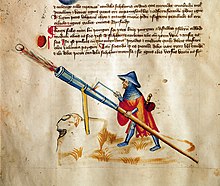Ignition iron
The ignition iron , also loose iron , ignition hook or ignition iron is an ignition means for early muzzle-loading weapons and cannons . Found practical use in the 17th century until the 17th century. Historical names from this period include: entcyndeeisen (ignition iron ), czundehoken (firing hook), or pengeisen (receiving iron ).
construction
Loose irons usually consist of an iron rod bent like an oven hook , which is pointed at the end of the hook or provided with an olive-shaped tip. Loose irons for larger guns such as cannons or mortars have a nozzle at the rear end with which they are placed on a wooden rod up to two meters long so that the gunner can ignite the gun with a minimal safety distance.
application
To ignite the guns, the tip of the loose iron must be made glowing in a fire and then placed in the ignition hole filled with igniter or on the powder pan. The detonating herb ignites at the hot loose iron tip and burns along the detonation hole into the gun powder chamber, where it ignites the gun's propellant charge . In order to be able to reliably ignite the ignition herb, the tip must be significantly hotter than the ignition temperature of the black powder of 170 ° C. To do this, the loose iron must be quickly removed from the fire and placed on the ignition hole. This circumstance requires that the gunner in the immediate vicinity of the gun not only has to handle gunpowder to load the gun, but also with an open fire in a brazier or a fire basket. This had a high potential for accidents, as sparks blowing from the brazier could easily ignite spilled powder or cause gunpowder stocks to explode.
As a result, the ignition increasingly prevailed by means of a slowly smoldering fuse on a matchstick, with which the igniter was ignited in the ignition hole. These are easier and safer to handle, they can be kept glowing and since the risk of sparks flying around unintentionally is significantly lower. The development of fuses or safety fuses finally made the detonator in the cans superfluous, as the propellant charge could be ignited directly with them.
If a cannon had to be abandoned when retreating , the tip of the ignition iron or a simple iron nail was driven into the ignition hole and broken off to make the weapon unusable.
literature
- Volker Schmidtchen: Bombards, fortifications, gunsmiths: From the first wall breakers of the late Middle Ages to the siege artillery of the Renaissance . Droste, Düsseldorf 1977, ISBN 3-7700-0471-X , p. 60-62 .
- Sean McLachlan: Medieval Handgonnes: The first black powder infantry weapons . Osprey, Oxford 2010, ISBN 978-1-84908-155-9 , pp. 4, 39 (English).
Web links
- Gunner with fire basin and loose iron , miniature in Jean Mansel's handwriting La fleur des histoires , Bibliothèque de Genève, Ms. fr. 64, fol.196r (digitized version)
- Types of ignition on www.bummsbrigade.de
Individual evidence
- ↑ Bernhard Rathgen: The gun in the Middle Ages . VDI-Verlag, Berlin 1928, p. 25, 439 .
